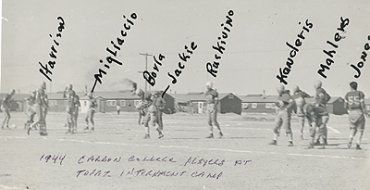This coming Thursday is the anniversary date of one of the darkest days in American history.
On Feb. 19, 1942 President Franklin D. Roosevelt signed Executive Order 9066 ordering that all Japanese-Americans along the United States West Coast to be interned at relocation camps inland from the coast.
This order brought about the establishment of the Topaz internment camp near Delta, a camp named after the nearby Topaz Mountains.
As a result of this order, over 8,000 Japanese-Americans were eventually interred at Topaz, most of them from the Northern California area.
In a way eastern Utah’s local junior college, then known as Carbon College, had a small role in the history of Topaz.
At the height of World War II during the fall of 1944 a small group of young men attending Carbon College expressed a desire to continue playing football after playing for Carbon High the previous year. Most were awaiting a greeting from Uncle Sam for induction into military service.
Someone came up with the idea of recruiting the third string players off the high school team at the time and combining them with the college students to form a team. The effort was facilitated by the fact that Carbon High and Carbon College had a joint student body at the time, sharing college buildings, teachers and even administration.
George (Buck) Young, a faculty member of the school, was induced to coach the team and Jackie Aramaki, ironically a Japanese-American himself, was recruited as the assistant coach. Aramaki had won state-wide acclaim prior to the war as a speedy running back on his Carbon High team.
The new team struggled along, seeking games where ever possible, mostly with the junior varsity teams of the state’s major colleges. It actually held the distinction as the only junior college team in the United States during that war year.
Word came that a high school age football team had been organized at Topaz and they were seeking games. Young arranged a home and home series for his team with the Topaz players. The first game was scheduled for Topaz with the Japanese-American team coming to Price weeks later.
Helper resident Walt Borla was a member of the Carbon team and made the trip to Topaz. He was attending school and working nights as a tender of the steam locomotive engines at the Rio Grande’s roundhouse in Helper for .65 cents an hour. Like everyone his age he was pending a call to become part of the war effort.
Borla recalls that he worked the night before going to Topaz and slept on the bus almost the entire trip. The officials at the internment camp had scraped away the sage brush on a large area, leveled the ground, put up some goal posts and lined the field for football.
“Every time one of us made a tackle we came up with a mouthful of dirt,” said Borla. “There were no bleachers at the field and it appeared that all 8,000 residents stood shoulder to shoulder to see the game.”
After the game the Topaz team hosted the Carbon players to a luncheon in the large wooden constructed gymnasium that the government had provided for the camp.
About all Borla can recall of the trip besides the game was the row after row of wooden barracks lined with black tar paper that provided the living quarters for the internees. He was impressed with the apparent industrialist manner of the residents. There were numerous vegetable gardens adjoining the barracks. The camp also had its own newspaper, The Topaz Times.
Topaz’s team made the journey to Price later in the fall for another game at the Carbon field.
So which team won the games? Borla says he doesn’t even remember.
“The only thing I remember about the game at Carbon was that I scored the only touchdown of my brief football career,” he said. “It came when I recovered a Topaz fumble in the end zone.”
During the time of the internment at these camps several internees were given the opportunity to come to Carbon County to work at the mines. Two dentists, Dr. Joe Abe at first and later Dr. Tosh Furukawa, were allowed to come to Helper and set up a dental practice.
One young lady, Mari Aayagi, was allowed to come to Helper to work in a local restaurant operated by a Japanese-American family. The restaurant, operating 24/7, was vital to provide food service for the railroad crews during their layovers from Grand Junction or Salt Lake City. She met her future husband here in Carbon County and remained to raise her family in Helper.
The Japanese-American internment camp, Topaz, in the west Utah desert near Delta, was closed on Sept. 2, 1945 shortly after the end of World War II.
A marker was erected at the site in 1976 and the site was designated a National Historic Landmark in 2007.
Years later the United States government compensated the internees to a degree for the unforgettable experience they suffered in camps like Topaz.
World War II game a unique event of its time

"Players from Carbon line up for a play during one of the two games between Topaz and Carbon College at Topaz."
